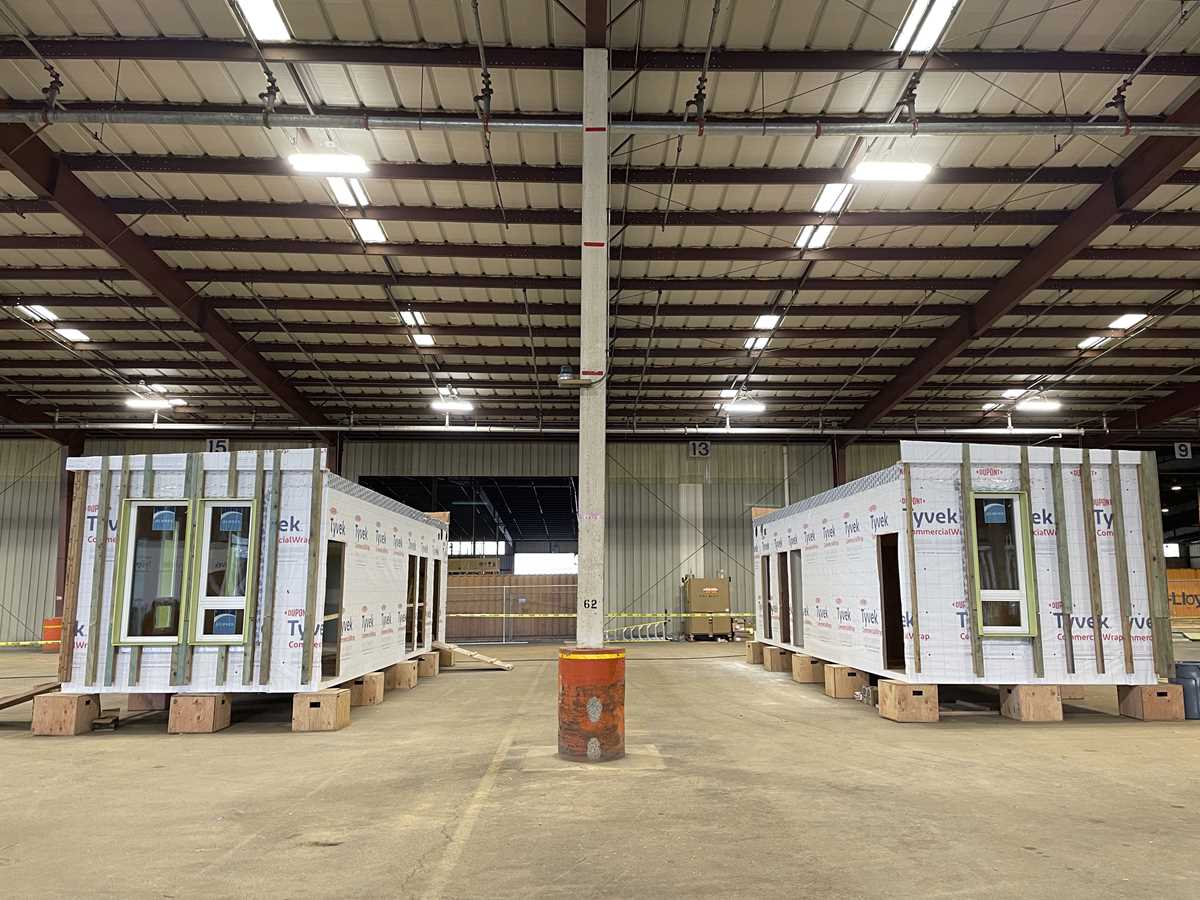 In this Feb. 26, 2015 photo, a front end log loader transports logs at Swanson Group Manufacturing in Roseburg, Ore. In Oregon, mass timber is increasingly being viewed as a construction material that could help the state build more affordable homes and revive rural logging towns. A new prototype of a mass timber affordable housing unit was unveiled at the Port of Portland on Friday, Jan. 27, 2023. (Michael Sullivan/The News-Review via AP, File)
In this Feb. 26, 2015 photo, a front end log loader transports logs at Swanson Group Manufacturing in Roseburg, Ore. In Oregon, mass timber is increasingly being viewed as a construction material that could help the state build more affordable homes and revive rural logging towns. A new prototype of a mass timber affordable housing unit was unveiled at the Port of Portland on Friday, Jan. 27, 2023. (Michael Sullivan/The News-Review via AP, File)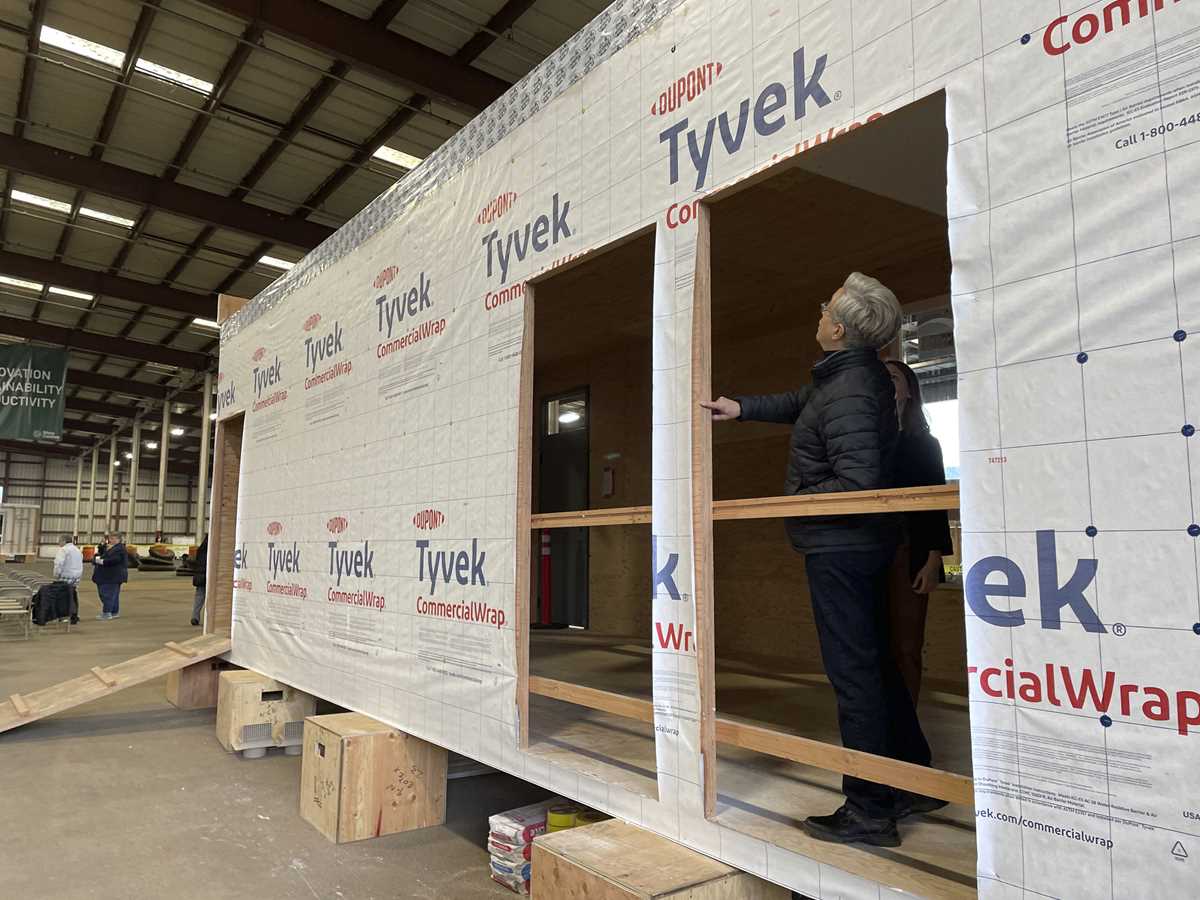 In this photo taken Thursday, Feb. 26, 2015, a forklift operator moves lumber at Swanson Group Manufacturing in Roseburg, Ore. In Oregon, mass timber is increasingly being viewed as a construction material that could help the state build more affordable homes and revive rural logging towns. A new prototype of a mass timber affordable housing unit was unveiled at the Port of Portland on Friday, Jan. 27, 2023. (AP Photo/The News-Review, Michael Sullivan, File)
In this photo taken Thursday, Feb. 26, 2015, a forklift operator moves lumber at Swanson Group Manufacturing in Roseburg, Ore. In Oregon, mass timber is increasingly being viewed as a construction material that could help the state build more affordable homes and revive rural logging towns. A new prototype of a mass timber affordable housing unit was unveiled at the Port of Portland on Friday, Jan. 27, 2023. (AP Photo/The News-Review, Michael Sullivan, File) Mass timber affordable home prototypes are shown at the Port of Portland in Portland, Ore. Friday, Jan. 27, 2023. The prototype was built in a warehouse at the port. The Oregon Mass Timber Coalition aims to open a factory at the site that could mass produce homes and potentially alleviate the state's housing shortage. (AP Photo/Claire Rush)
Mass timber affordable home prototypes are shown at the Port of Portland in Portland, Ore. Friday, Jan. 27, 2023. The prototype was built in a warehouse at the port. The Oregon Mass Timber Coalition aims to open a factory at the site that could mass produce homes and potentially alleviate the state's housing shortage. (AP Photo/Claire Rush) Oregon Gov. Tina Kotek examines a mass timber affordable housing prototype at the Port of Portland in Portland, Ore., Friday Jan. 27, 2023. The Oregon Mass Timber Coalition aims to open a factory at the port that could mass produce homes and potentially alleviate the state's housing shortage. (AP Photo/Claire Rush)
Oregon Gov. Tina Kotek examines a mass timber affordable housing prototype at the Port of Portland in Portland, Ore., Friday Jan. 27, 2023. The Oregon Mass Timber Coalition aims to open a factory at the port that could mass produce homes and potentially alleviate the state's housing shortage. (AP Photo/Claire Rush) Barbara Benedict shows pictures of her home in Otis, Ore. that burned down in the Echo Mountain Complex fire. The 2020 Labor Day wildfires devastated southern Oregon and destroyed thousands of homes. Once completed, Barbara and Scott Benedict will be the first people to receive one of the mass timber affordable housing units that were on display, in prototype form, at the Port of Portland, in Portland, Ore. Friday, Jan. 27, 2023. (AP Photo/Claire Rush)
Barbara Benedict shows pictures of her home in Otis, Ore. that burned down in the Echo Mountain Complex fire. The 2020 Labor Day wildfires devastated southern Oregon and destroyed thousands of homes. Once completed, Barbara and Scott Benedict will be the first people to receive one of the mass timber affordable housing units that were on display, in prototype form, at the Port of Portland, in Portland, Ore. Friday, Jan. 27, 2023. (AP Photo/Claire Rush)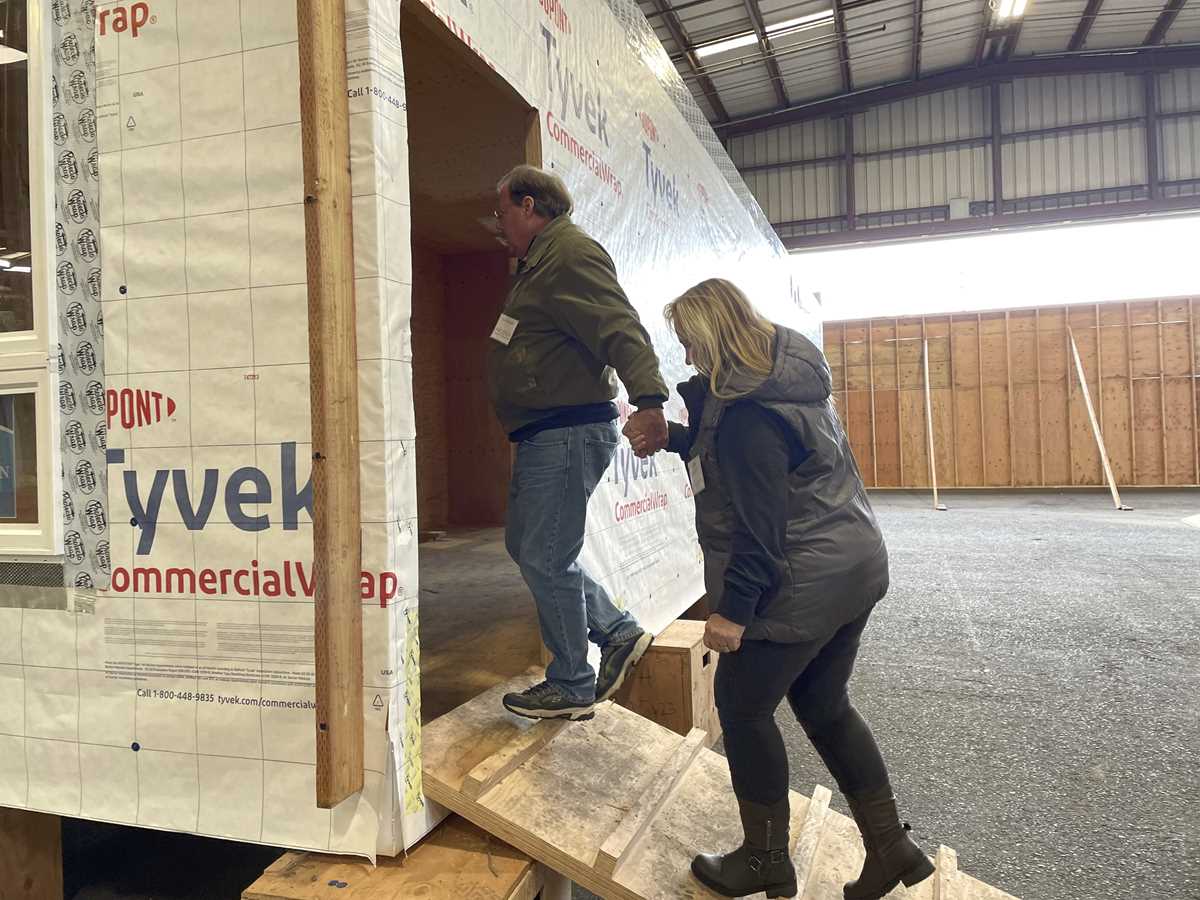 Barbara and Scott Benedict walk inside the mass timber affordable housing prototype that will soon become their new home while at the Port of Portland, Friday, Jan. 27, 2023 in Portland, Ore. The couple lost their home in the 2020 Labor Day wildfires that devastated southern Oregon and destroyed thousands of homes. (AP Photo/Claire Rush)
Barbara and Scott Benedict walk inside the mass timber affordable housing prototype that will soon become their new home while at the Port of Portland, Friday, Jan. 27, 2023 in Portland, Ore. The couple lost their home in the 2020 Labor Day wildfires that devastated southern Oregon and destroyed thousands of homes. (AP Photo/Claire Rush)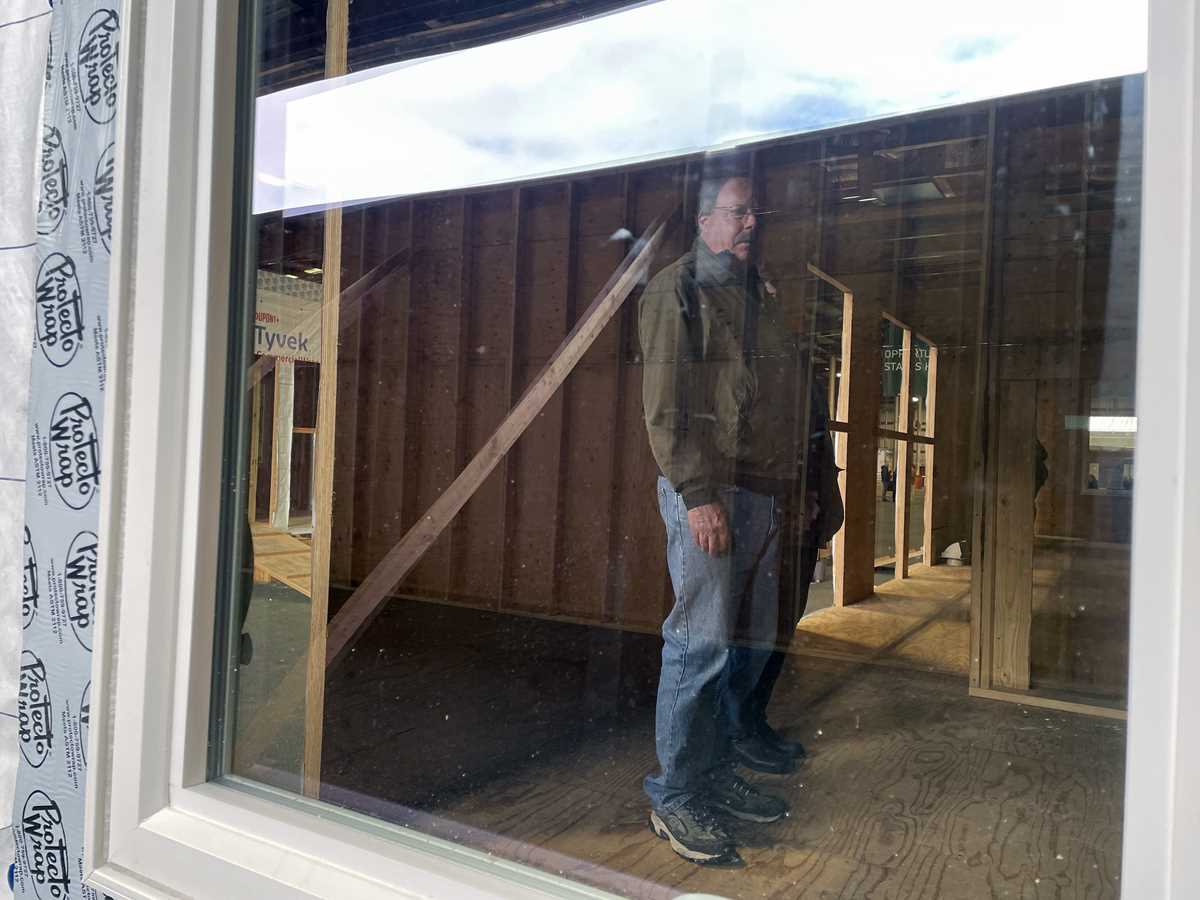 Scott Benedict checks out the inside of the mass timber affordable housing prototype that will soon become his new home while at the Port of Portland, Friday, Jan. 27, 2023 in Portland, Ore. Scott and Barbara Benedict lost their home in the 2020 Labor Day wildfires that devastated southern Oregon and destroyed thousands of homes. (AP Photo/Claire Rush)
Scott Benedict checks out the inside of the mass timber affordable housing prototype that will soon become his new home while at the Port of Portland, Friday, Jan. 27, 2023 in Portland, Ore. Scott and Barbara Benedict lost their home in the 2020 Labor Day wildfires that devastated southern Oregon and destroyed thousands of homes. (AP Photo/Claire Rush)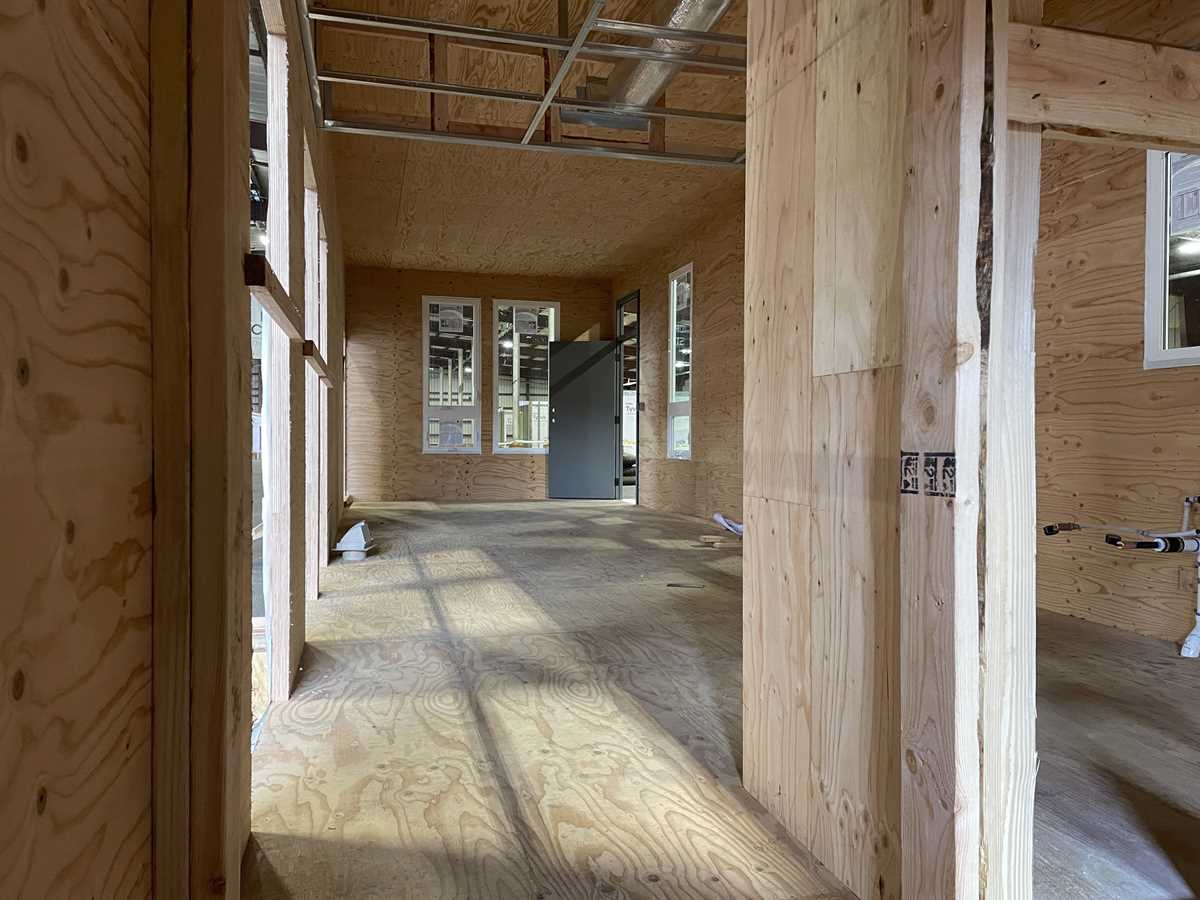 The inside of a mass timber affordable housing prototype at the Port of Portland on Friday, Jan. 27, 2023 in Portland, Ore. The Oregon Mass Timber Coalition aims to open a factory at the site that could mass produce homes and potentially alleviate the state's housing shortage. (AP Photo/Claire Rush)
The inside of a mass timber affordable housing prototype at the Port of Portland on Friday, Jan. 27, 2023 in Portland, Ore. The Oregon Mass Timber Coalition aims to open a factory at the site that could mass produce homes and potentially alleviate the state's housing shortage. (AP Photo/Claire Rush)PORTLAND, Ore. (AP) — Inside a warehouse at the industrial Port of Portland lies what some believe could be the answer to Oregon's housing crisis — a prototype of an affordable housing unit made from mass timber.
Once mass-produced at the factory being planned at the port, the units ranging from 426 square feet (40 square meters) to 1,136 square feet (106 square meters) could be deployed across the state to be assembled in urban and rural communities alike, potentially alleviating a critical housing shortage that has driven Oregon's high rates of homelessness.
“I can't wait to see these homes rolling down the road to those communities who need them right now,” said newly inaugurated Democratic Gov. Tina Kotek, who visited the prototypes Friday. “We have to do this day in and day out in order to meet the goals of providing enough housing for every Oregonian in this state. Because that is the long-term solution to end homelessness.”
On her first full day in office earlier this month, Kotek signed an executive order setting a new housing construction target of 36,000 units per year — an 80% increase over current production — in a bid to address the state's housing shortage.
Mass timber has yet to be widely adopted for affordable housing construction. While Oregon officials are seeking to change that, some environmental groups have expressed concern that increased logging could lead to deforestation if not managed sustainably, which could add to global warming.
Mass timber is made from layers of wood that are stacked, often in perpendicular layers, then compressed and fastened together to make large panels or beams. Already popular in Europe, where it was developed in the 1990s, mass timber is gaining ground in the U.S. The tallest mass timber building in the world, the 25-story Ascent MKE building, opened in Milwaukee last summer, surpassing Norway’s 18-story Mjostarnet tower.
Proponents of mass timber say it uses less energy and emits less carbon than concrete and steel. They also claim it can help reduce wildfire risk, as the material can be made of the smaller trees in a forest’s underbrush. And they point to the rural jobs the industry can create.
The Oregon Mass Timber Coalition received a $41 million federal grant last year to help finance the construction of the housing factory at the Port of Portland. Members of the coalition, which is made up of government agencies and Oregon universities, say the factory would make it easier to produce prefabricated homes.
“The beauty of it is, you can cut the openings required for electrical and plumbing and stuff like that,” said Iain MacDonald, director of the TallWood Design Institute, a member of the coalition. “And you can do all that on a computer-controlled machine in the factory. Then when you get to the job site, it’s a really fast assembly. It’s basically an assembly operation rather than a construction operation.”
The TallWood Design Institute is a collaboration between the University of Oregon and Oregon State University.
Producing more factory homes also would allow the state to ramp up housing despite a labor shortage that’s seized the manufacturing and construction industries, MacDonald said.
But some environmental groups say cutting down more trees will release more carbon and reduce forests' ability to absorb carbon from the atmosphere.
“The business has gone toward clear cutting, spraying, replanting and cutting them down 35 years later,” said Sean Stevens, executive director of conservation organization Oregon Wild. “When you do that 40-year rotation, you never let them get to that point where they could really contribute to storing more carbon. You’re treating it like a crop at that point.”
Environmental groups have also pushed back on the idea that cutting younger trees will mitigate wildfire risk.
“The reason we’re having big fires today is extreme fire weather that is triggered mostly by climate change, high winds, hot temperatures, low humidity,” said Dominick DellaSala, chief scientist at conservation organization Wild Heritage. “I think there’s some credibility with taking smaller trees, but it isn’t going to solve the fire problem.”
Some wildfire victims, however, are set to directly benefit from the units. The first completed prototype will go to a couple, Barbara and Scott Benedict, who lost their home in the 2020 Labor Day wildfires that devastated southern Oregon.
“You can’t really say what it means to you,” Scott Benedict said of the new home, which is expected to be delivered to his property in the small town of Otis a few months from now. "We’ve been without a home for 2 1/2 years.”
Affordable housing developers say that using mass timber will allow them to move quicker to rebuild after crises like wildfires and to address systemic issues like the housing shortage.
Ernesto Fonseca, CEO of Hacienda CDC, the Portland nonprofit that worked on designing the prototypes at the city's port, said it took about six weeks to build six model units. When the factory becomes fully operational, Fonseca estimated it could produce four to six units per day, compared to three to four years for a more traditional project.
“The most significant aspect of this is speed,” Fonseca said. “Rapid rehousing became our driving principle.”
The units will initially range in price from $200,000 for a studio to about $400,000 for a three-bedroom unit, according to Fonseca. He said that he expects prices to go down once the factory is up and running a few years from now. The median sale price of a home in Oregon was $473,400 as of December, according to the online real estate brokerage site Redfin.
Oregon is short 110,000 housing units and needs to build more than a half-million homes over the next 20 years in order to keep up with demand, officials have estimated. The goal of building 36,000 new homes per year outlined in Kotek’s executive order would allow the state to meet that target. Housing advocates have welcomed the order but say that removing bureaucratic red tape will be key to making sure that quota is met.
___
Claire Rush is a corps member for the Associated Press/Report for America Statehouse News Initiative. Report for America is a nonprofit national service program that places journalists in local newsrooms to report on undercovered issues. Follow Claire on Twitter.
Before you make your next trade, you'll want to hear this.
MarketBeat keeps track of Wall Street's top-rated and best performing research analysts and the stocks they recommend to their clients on a daily basis.
Our team has identified the five stocks that top analysts are quietly whispering to their clients to buy now before the broader market catches on... and none of the big name stocks were on the list.
They believe these five stocks are the five best companies for investors to buy now...
See The Five Stocks Here
Growth stocks offer a lot of bang for your buck, and we've got the next upcoming superstars to strongly consider for your portfolio.
Get This Free Report
